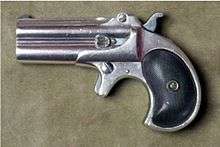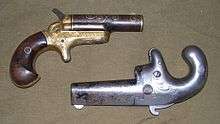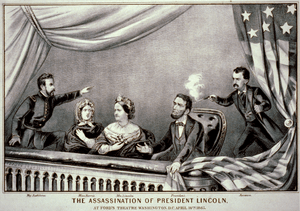Derringer





The term derringer [derr-in-gur] is a genericized misspelling of the last name of Henry Deringer, a famous 19th-century maker of small pocket pistols.[1] Many copies of the original Philadelphia Deringer pistol were made by other gun makers worldwide, and the name was often misspelled; this misspelling soon became an alternative generic term for any pocket pistol, along with the generic phrase palm pistol, which Deringer's competitors invented and used in their advertising. The original Deringer pistol was a single-shot muzzleloading pistol; with the advent of cartridge firearms, pistols began to be produced in the modern form still known as a derringer.[2]
Design

A derringer is generally the smallest usable handgun of a given caliber. They were frequently used by women, because they are easily concealable in a purse or as a stocking gun.[3] Such weapons designed specifically for women were called "muff pistols", due to their compact size enabling them to be carried in a muff.[4] Derringers are not repeating firearms—repeating mechanisms such as those used in semi-automatic handguns and/or revolvers would add significant bulk to the gun, defeating the purpose.[4] The original cartridge derringers held only a single round, usually a pinfire or rimfire .40 caliber cartridge, with the barrel pivoted sideways on the frame to allow access to the breech for reloading. The famous Remington derringer design doubled the capacity, while maintaining the compact size, by adding a second barrel on top of the first and pivoting the barrels upwards to reload. Each barrel then held one round, and a cam on the hammer alternated between top and bottom barrels. The Remington derringer was in .41 Short caliber and achieved wide popularity. The .41 Short bullet moved very slowly, at about 425 feet per second (130 m/s), around half the speed of a modern .45 ACP. It could be seen in flight, but at very close range, such as at a casino or saloon card table, it could easily kill. The Remington derringer was sold from 1866 to 1935.[5]
The classic Remington design remained popular even with the advent of smaller, higher-powered cartridges, made possible by the use of smokeless powder, rather than the black powder used in the 19th century and before. A Remington-pattern derringer in .38 Special is still smaller than the most compact .25 ACP semiautomatic, and provides superior terminal ballistic performance to the .25 ACP. While the classic Remington design is a single-action, manufacturers have also made double-action derringers, including some four-shot models, with the barrels stacked in a 2 × 2 block. The COP 357 Derringer provided four shots of .357 Magnum in a package not much larger than a .25 ACP automatic, and was significantly more compact than a similar revolver. The COP derringer was invented by Robert Hillberg and closely resembled his earlier work on insurgency weapons.[6]
A related design, often grouped with derringers since it fits no other standard classification, is the Semmerling pistol.[7] It is a five-shot, .45 ACP pistol with a manual repeater: the barrel mechanism is manually pulled forward to eject the fired round, then pushed back to chamber the next round. These pistols were originally built for the United States Army, and the few available on the civilian market are highly sought after due to their unique combination of high power, large capacity, and tiny size. Another military pistol that is truly a derringer design is the FP-45 Liberator, a .45 ACP insurgency weapon dropped behind Axis lines in World War II.[8]
The Remington derringer design is still being manufactured; Bond Arms, Cobra Arms and American Derringer all manufacture the over/under derringer in a variety of calibers from .22 long rifle to .45 Long Colt.[9] The current production of derringers are used by Cowboy Action Shooting reenactors as well as a concealed-carry weapon. It is the smallest handgun that is capable of handling the largest ammunition. Some favor the derringer as a concealed carry weapon because of its size as well as the swiftness of putting it into action. Critics believe it is not an adequate weapon for self-defense since the derringer possesses only a two-shot capacity.
Philadelphia Deringer
The Philadelphia Deringer was a small percussion handgun designed by Henry Deringer (1786–1868) and produced from 1852 through 1868. A popular concealed carry handgun of the era, this pocket pistol design was widely copied by competitors, sometimes down to the markings.[10]
For loading a Philadelphia Deringer, one would typically fire a couple of percussion caps on the handgun, to dry out any residual moisture contained in the tube or at the base of the barrel, to prevent a subsequent misfire. One would then remove the remains of the last fired percussion cap and place the handgun on its half-cock notch, pour 15 to 25 grains (1 to 2 g) of black powder down the barrel, followed by ramming a patched lead ball down onto the powder, being very careful to leave no air gap between the patched ball and the powder, to prevent the handgun from exploding when used. (The purpose of the patch on the ball was to keep the ball firmly lodged against the powder, to avoid creating what was called a "short start" when the ball was dislodged from being firmly against the powder.)
A new percussion cap would then be placed on the tube (what today would be called a nipple), and the gun was then loaded and ready to fire. (The half-cock notch prevented the hammer from falling if the trigger were bumped accidentally while carrying the handgun in one's coat pocket.) Then, to fire the handgun, a user would fully cock the hammer, aim, and squeeze the trigger. Upon a misfire, the user could fully re-cock the hammer, and attempt to fire the handgun once more, or, equally common, switch to a second Deringer. Accuracy was highly variable; although front sights were common, rear sights were less common, and some Philadelphia Deringers had no sights at all, being intended for point and shoot use instead of aim and shoot, across Poker-table distances. Professional gamblers, and others who carried regularly, often would fire and reload daily, to decrease the chance of a misfire upon needing to use a Philadelphia Deringer.[4]

Henry Deringer's production records, and contemporaneous records of his imitators, indicate that these pistols were almost always sold in matching pairs. (A typical price was $15 to $25 for a pair, with silver-inlaid and engraved models selling at higher prices.) The choice of buying a pair, in part, was to compensate for the limited power of a single-shot, short-barreled pistol, and to compensate for a design considerably less reliable than subsequent cartridge derringer designs. Original Deringers are almost never found still in their matched pairs today.[1]
Initially popular with military officers, the Deringer became widely popular among civilians who wished to own a small and easily concealable pistol for self-defense.[4]
In total, approximately 15,000 Deringer pistols were manufactured.[1] All were single barrel pistols with back action percussion locks, typically .41" rifled bores, and walnut stocks. Barrel length varied from 1.5" to 6", and the hardware was commonly a copper-nickel alloy known as "German silver". The back action lock was a later, improved design among locks, which had its spring and mechanism located behind the hammer, where it was thereby protected from dirt, fired cap residue, and gunpowder residue unlike earlier front action locks that had their springs and mechanism located directly in the path of such residue in front of the hammer, under the tube.[4]
Because of their small size and easy availability, Deringers sometimes had the dubious reputation of being a favored tool of assassins. The most famous Deringer used for this purpose was fired by John Wilkes Booth in the assassination of Abraham Lincoln. Booth's Deringer was unusual in that the rifling twisted counterclockwise (left-handed twist), rather than the typical clockwise twist used on most Philadelphia Deringers.[10]
Remington Derringer
The Remington over-under double-barreled derringers were manufactured from 1866 until 1935. The gun was made only in .41 rim fire short. There are four models with several variations. The first model, first variation is only the first 100 made and were marked "MANUFACTURED BY E. REMINGTON & SONS" on one side rib, and "ELLIOTS PATENT DEC 12 1865" on the other side rib. These are very rare. The second variation is marked the same without the "manufactured by". The third variation has an extractor on the left side and is referred to as a "extractor cut." The fourth variation is marked, "REMINGTONS ILLION NY" and is very rare.
The second model is marked on the top rib in two lines, "E REMINGTON & SONS ILION NY," ""ELLIOTS PATENT DEC 12 1865". There are no variations.
In 1888 Remington went bankrupt and was bought by Hartley and Graham of New York. The company name was changed to Remington Arms Co., and beginning in 1889 all Remington guns were marked with that name. The third model was made in 6 variations, all marked, ""REMINGTON ARMS CO, ILION NY". on the top rib. The variations are determined by the font style. The first variation of the third models were serialized, but all other variations were marked in batches, not with serial numbers. After the merger between Remington and UMC Cartridge Co in 1910, beginning in 1911, the fourth models were marked "REMINGTON-U.M.C.CO.ILION,N.Y." and were serialized. Starting in 1922, all Remington guns were stamped with a two letter date code for the shipping month and year. The second variation has strengthened hinges and serial numbers that begin with the letter "L", These were marketed as the Model 95. The third and final model has no side rib and is referred to as a "monoblock". About 500 monoblocks were made through 1935, with only ten guns shipped after that.
Above information is from the book, "Dr. William H. Elliot's Remington Double Derringer." Graphic Publishers, 2008, ISBN 1-882824-35-0
In popular culture
Remington derringers often played critical roles in the exploits of James T. West, fictional Secret Service agent, in the American television series The Wild Wild West. He would carry up to three derringers: one as a concealed carry backup gun to his holstered and openly carried full sized revolver. This derringer was carried either in a vest pocket or an inside pocket of his jacket. Another derringer was carried as a sleeve gun under his right shirt sleeve, and the third was broken into two parts with the barrel-chamber assembly hidden in the hollowed out heel of one boot and the frame hidden in the heel of the other.[11]
A single-shot Derringer was the concealed weapon of choice for Buford "Mad Dog" Tannen in Back to the Future Part III. He uses it to kill Dr. Emmett "Doc" Brown in a previous unseen-on-screen timeline. However, in the timeline seen in the movie, Tannen's attempt to kill Brown is thwarted when Marty McFly throws a pie plate at the Derringer in Tannen's outstretched hand. The gun discharges, hitting Brown's hat and knocking it off his head.[12]
In the Simpsons episode "Simpsons Tall Tales" the characters Bart and Nelson are portrayed as Tom Sawyer and Huckleberry Finn. The two start a barroom brawl on a Mississippi river gambling boat, in which the bar patrons fire comically weak Derringer pistols. The bullets all bounce off their intended victims and they escape unharmed.
In the 2002 remake of Resident Evil, a Derringer (or 'self defense gun') can be found in the Residence. It only has a single .22 magnum round left in the chamber, and cannot be reloaded, but is powerful enough to kill almost any enemy in the game.
In Assassin's Creed Syndicate, a Derringer pistol is seen many times in the game as a weak firearm, and is the first pistol in the game.
See also
- .41 Short
- Bond Arms Derringer Manufacture
- Cobray
- Deer gun
- DoubleTap pistol
- FP-45 Liberator
- Garrucha
- National Arms Company
- Protector Palm Pistol
References
Flayderman, Norm (3 December 2007). Flayderman's Guide to Antique American Firearms and Their Values. Iola, Wisconsin: Gun Digest Books. ISBN 1-4402-2651-2.
Footnotes
- 1 2 3 Flayderman (2007)pp. 410-412
- ↑ Chapel, Charles Edward (19 September 2013). Guns of the Old West: An Illustrated Guide. Courier Dover Publications. pp. 104–106. ISBN 978-0-486-42161-2.
- ↑ Carter, Gregg Lee (1 January 2002). Guns in American Society: An Encyclopedia of History, Politics, Culture, and the Law. ABC-CLIO. p. 159. ISBN 978-1-57607-268-4.
- 1 2 3 4 5 Boorman, Dean K. (1 November 2004). Guns of the Old West: An Illustrated History. Globe Pequot Press. pp. 28–35. ISBN 978-1-59228-638-6.
- ↑ Marcot, Roy M. (2005). The History of Remington Firearms. Lyons Press. p. 32. ISBN 978-1-59228-690-4.
- ↑ Ahern, Jerry (5 October 2010). Gun Digest Buyer's Guide to Concealed-Carry Handguns. Iola, Wisconsin: Gun Digest Books. p. 130. ISBN 1-4402-1743-2.
- ↑ Shideler, Dan (14 April 2010). The Official Gun Digest Book of Guns & Prices 2010: Rifles, Pistols & Shotguns. Iola, Wisconsin: Gun Digest Books. pp. 35–36. ISBN 1-4402-1454-9.
- ↑ Thompson, Leroy (2012). The Colt 1911 Pistol. Osprey Publishing. p. 99. ISBN 978-1-84908-836-7.
- ↑ Ramage, Ken (5 August 2008). Gun Digest 2009: The World's Greatest Gun Book. Iola, Wisconsin: F+W Media, Inc. p. 308. ISBN 0-89689-647-1.
- 1 2 Russell, Carl Parcher (1 January 1980). Guns on the Early Frontiers: A History of Firearms from Colonial Times Through the Years of the Western Fur Trade. Omaha: U of Nebraska Press. pp. 138–139. ISBN 0-8032-8903-0.
- ↑ Biederman, Danny (14 October 2004). The Incredible World of Spy-fi: Wild and Crazy Spy Gadgets, Props, and Artifacts from TV and the Movies. Chronicle Books. p. 67. ISBN 978-0-8118-4224-2.
- ↑ Fhlainn, Sorcha Ní (12 May 2010). The Worlds of Back to the Future: Critical Essays on the Films. McFarland. p. 100. ISBN 978-0-7864-5765-6.
External links
| Wikimedia Commons has media related to Derringer. |
- The Booth Deringer--Genuine artifact or Replica?, a report of an FBI analysis of the Booth Deringer, made after rumors that the original had been stolen and replaced with a replica.
- Derringer